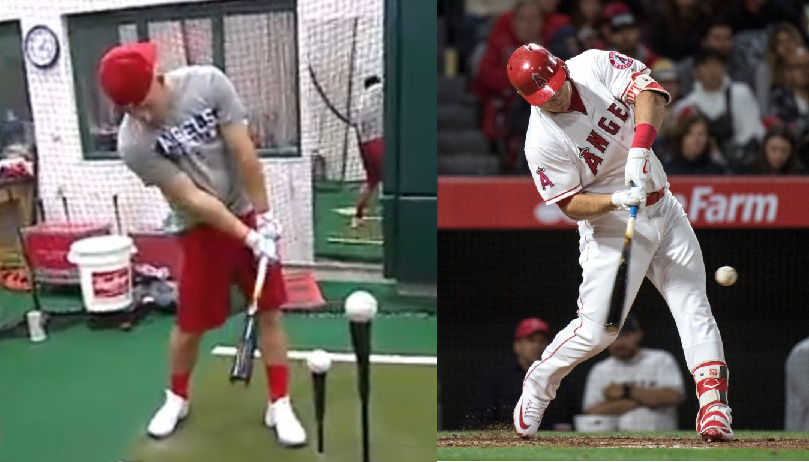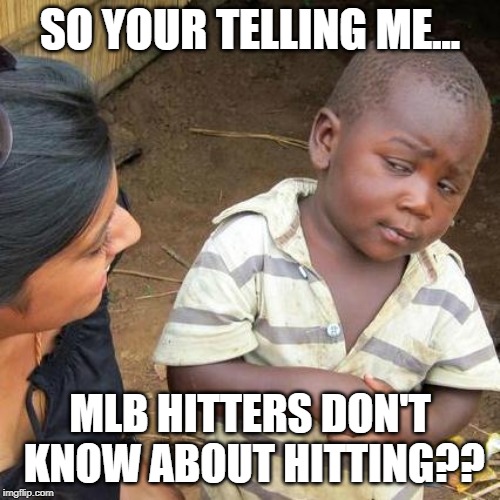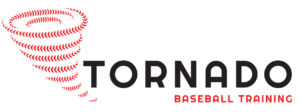
Frequently on MLB Network or ESPN, you will see star players being interviewed in the cage about their hitting philosophies and practice routines. Most of the time, these star players show a lack of understanding of what they are actually doing in games. Their demonstration swings look completely different than their game swings and they repeat common cliches that have been proven to be false.
There are numerous videos of many players, but lets look at an example with arguably the best player in baseball, Mike Trout.
There are a number of incorrect ideas Trout talks about. He says he swings the bat on a straight line down to the ball. I have talked about how elite hitters do not do this in several other blog posts, so I won’t do it again here, but that should be a red flag that he may not know exactly what he’s doing at the plate.
Also, lets also look at the position he thinks he should be in, right before contact on a low pitch, vs the position in games.

On the left, Trout’s are are fully extended,he is standing relatively tall and the angle between his left forearm and bat is roughly 135 degrees. On the right (in game), Trout’s arms are flexed, his torso is tilted more significantly over the plate and his left forearm and bat are in a straight line.
How can elite hitters be so far off?
The baseball swing is a very fast movement, and up until relatively recently, most coaches were not doing video analysis of the swing in slow motion. This led to many incorrect theories about the swing becoming commonplace. Baseball is a very traditional game, even down to coaching. Even though many incorrect swing thoughts can be easily proven wrong with high speed video, traditional baseball ideas persisted based on tradition.
Most elite players were naturally gifted when it comes to baseball. They never had to really focus on making swing changes. They were able to figure out the most efficient swing on their own, unconsciously. So when they are asked to explain what they are doing at the plate, they repeat what they have heard from their coaches for many years. These hitters assume these common coaching cues are what they are doing, not knowing that many of these ideas are not actually happening with elite hitters.
Some elite hitters may actually believe they are “swinging down” or “getting extension” at contact. These incorrect thoughts are an example of the “action-perception gap”. That means their perception of what they are doing when they swing, is different than the reality of the action of the swing. This is especially common is sports where the action and decision making process happens so fast.(Like baseball) Think about all the decisions and high speed body movements you have to make within 4 tenths of a second. It is very hard to know exactly what you are doing during that short amount of time, without studying slow motion video.
This excerpt is from the textbook page 43 of “Motor Learning and Performance, A problem based learning approach. Third Edition” By Richard A. Schmidt and Craig Wrisberg, talks about this further.
“Highly proficient performers are not always aware of how they do what they do. This is because many of the processes that operate during highly skilled performance are non-conscious…..A pertinent example comes from a study by Polanyi (1958), who found that champion cyclists could not explain the fundamental principles of balancing on the bicycle.
In addition, informal comments of expert performers are sometimes inconsistent with the findings of controlled research. For example, the late, great baseball batter Ted Williams was well known for his frequent claim that he was able to watch the seams of the ball rotate up to the moment of ball bat contact. This comment conflicts with scientific evidence concerning the length of visual information-processing time and the speed of eye movements. In cases like these, practitioners must exercise due caution before using the advice of experts.”
Some may argue that even though these elite hitters aren’t actually doing what they say they are. Their thoughts are still helpful for them and other hitters should still take their advice. For example, some argue along the lines of “if Mike Trout thinks that he is swinging down, then there must be some value to thinking that. How can the best player in baseball be thinking the wrong thing. I want my son to think swing down”
The problem with this line of thinking is that for every Mike Trout or A-Rod who thinks “swing down” and is an elite MLB hitter, there are thousands of youth and amateur players who have the same “swing down” thoughts and are not nearly on the level of hitting as Trout or A-Rod. This suggests that elite hitters like Trout, A-Rod and others are successful DESPITE their swing thoughts, NOT because of them.

The bottom line when it comes to learning from elite MLB hitters, is that it is important to focus on what they are actually doing, rather than what they are saying they are doing. If they give a piece of advice on the swing, make sure to check the advice against actual slow motion video of their swings to make sure they follow their own advice. In many cases, MLB hitter’s advice does not align with what they actually do in games.
I understand how it could be hard to believe that MLB hitters don’t know exactly what thy are doing at the plate. This is not to say that MLB hitters don’t know what they are PHYSICALLY doing. Elite hitters PHYSICALLY know exactly what they are doing when it comes to swinging a bat. However when it comes to CONCEPTUALLY explaining these unconscious actions, they tend to struggle. Think about it, their job is only to hit the ball, not to teach people how to hit the ball.
The best person to learn from about how to develop as a hitter is someone who has spent a lot time analyzing what elite hitters actually do and has physically gone through the process of trying emulate the swings of elite hitters. Hitting a baseball with proper technique and teaching someone how to hit a baseball with proper technique are two different skills. The best coaches can not only teach how to hit with proper technique, but are also personally able to hit with proper technique. That is a sign that they are able to use their knowledge of the swing and their knowledge of teaching the swing, to teach themselves how to swing the bat properly.
